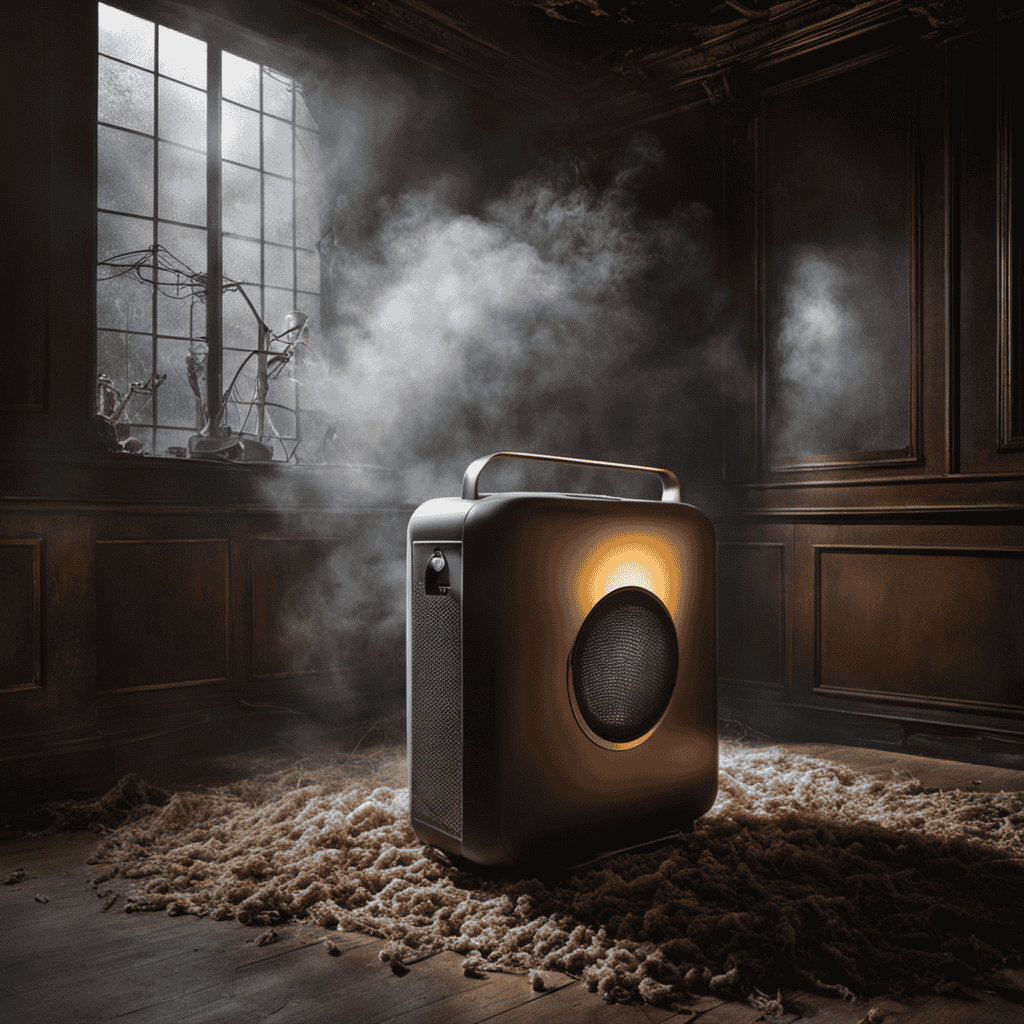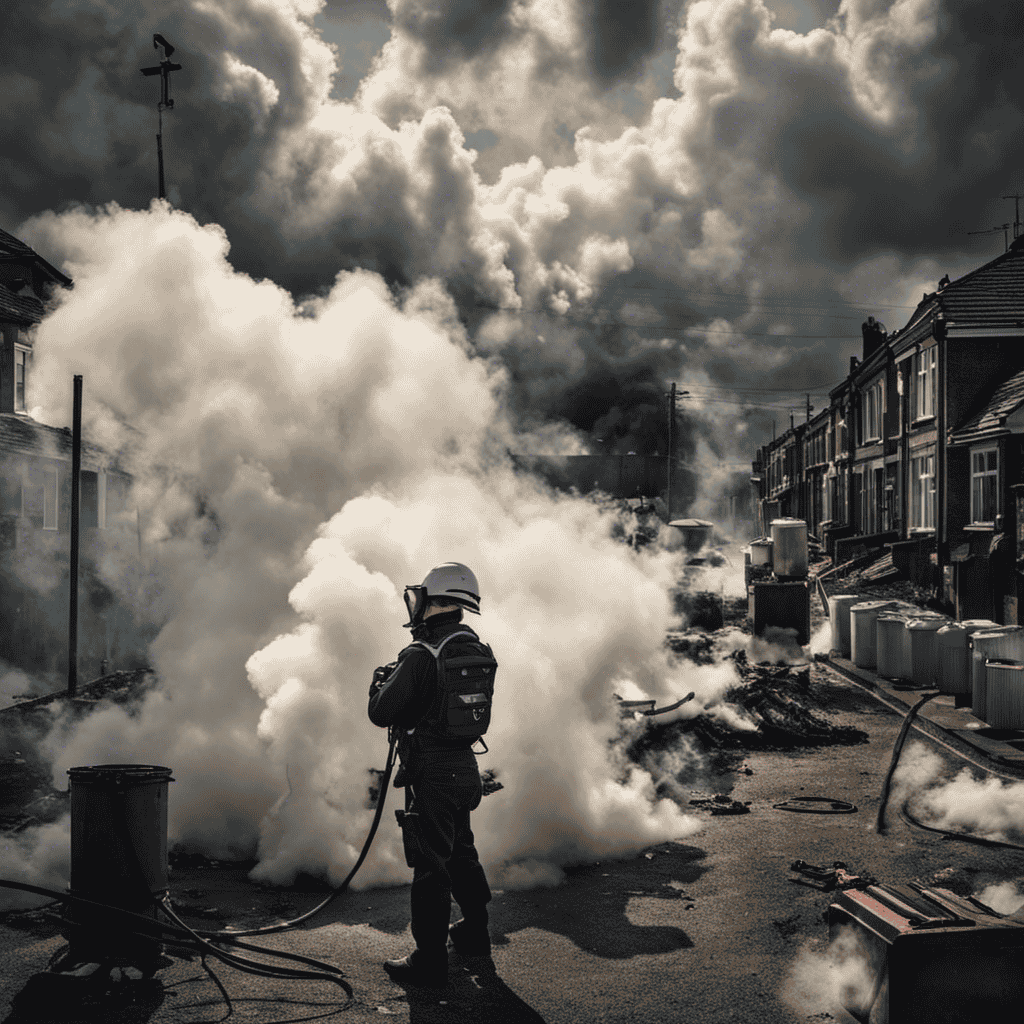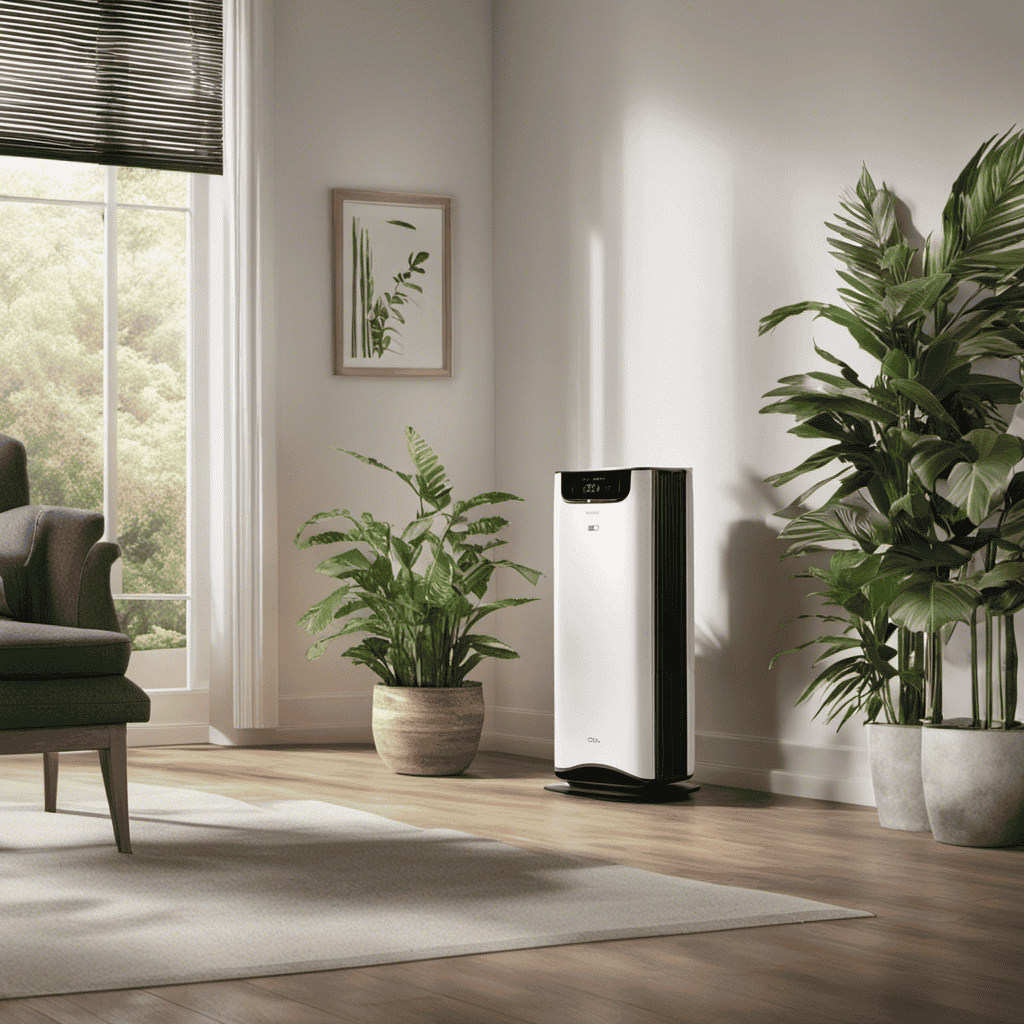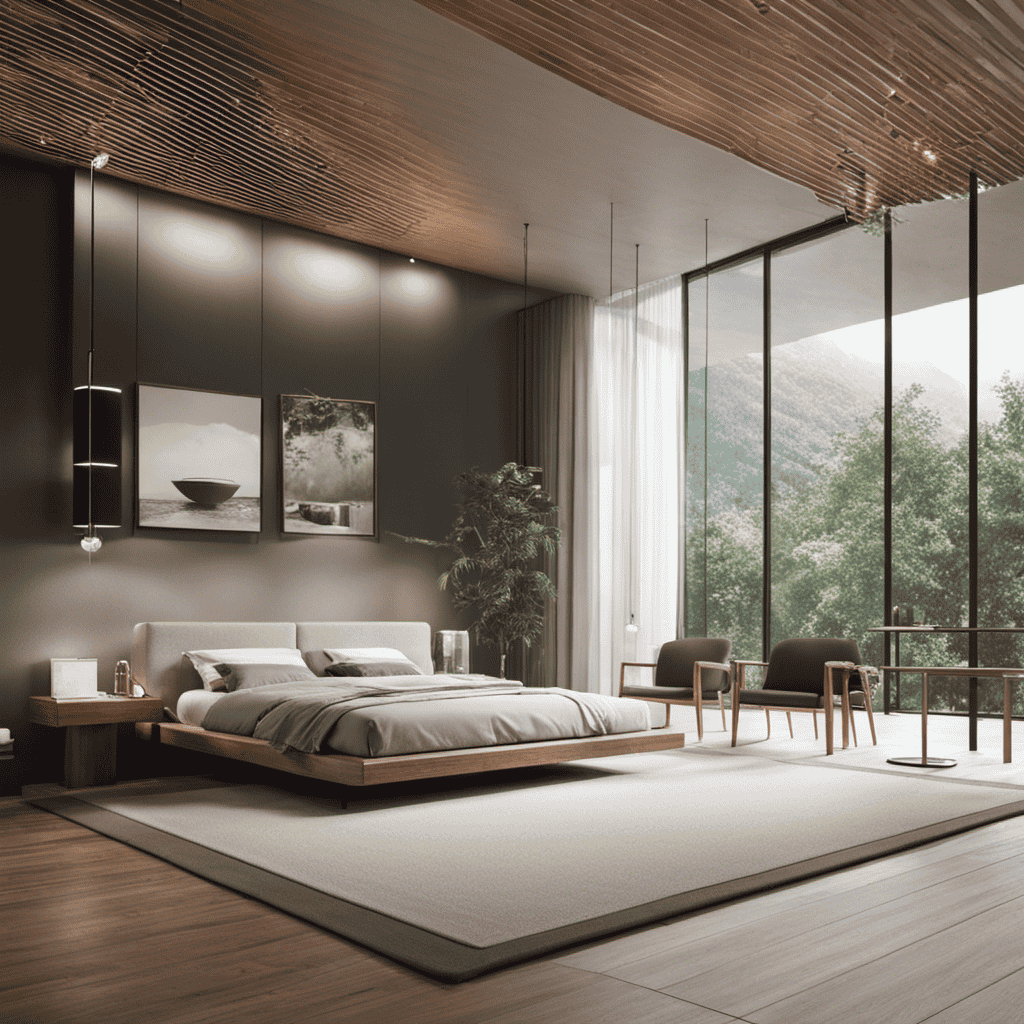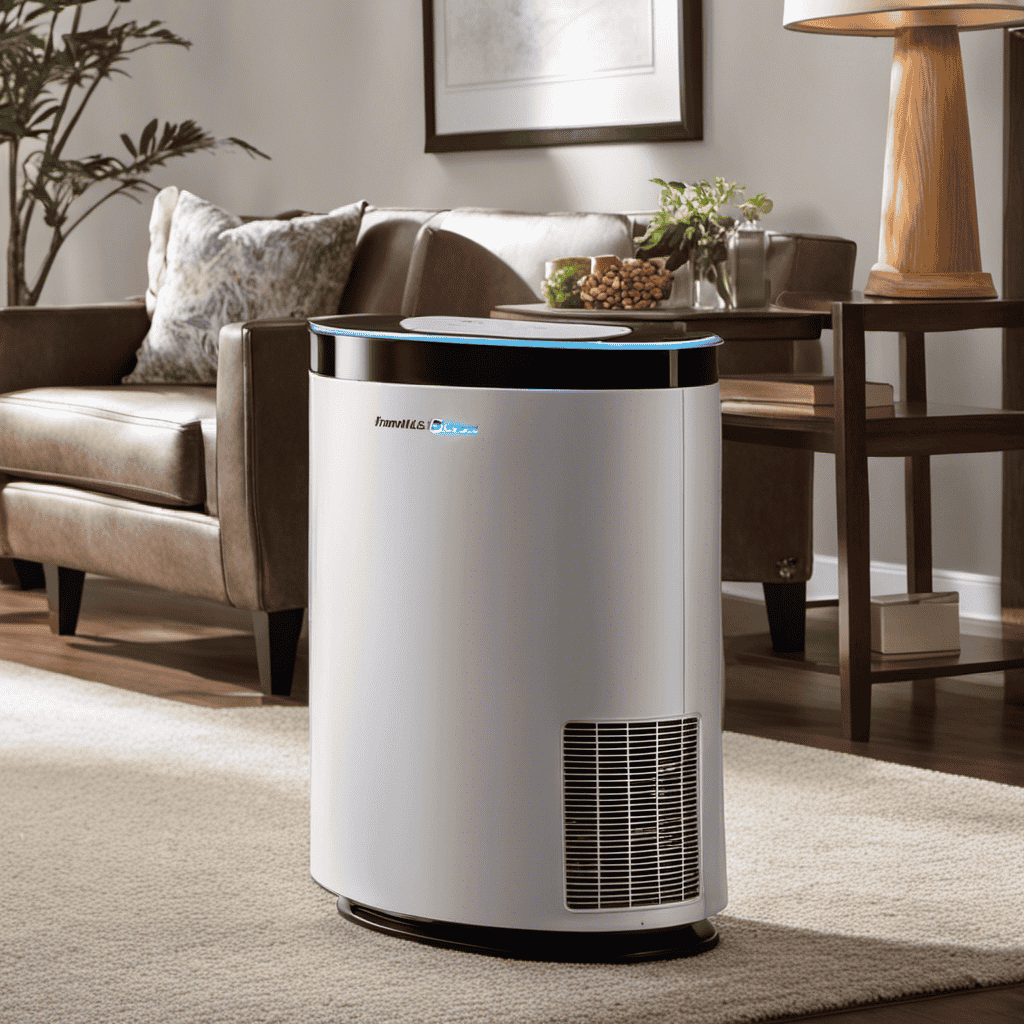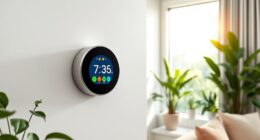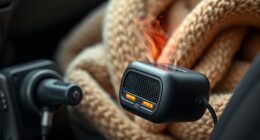Did you realize that an air purifier typically lasts between 5 to 10 years?
As a homeowner, I’ve come to realize the importance of knowing when it’s time to throw away an old air purifier and upgrade to a more efficient model.
In this article, I will provide you with practical tips and evidence-based information on how to assess the efficiency of your air purifier, common problems to watch out for, and when it’s time to replace filters or even upgrade your air purifier altogether.
Let’s dive in and ensure you have clean and healthy air in your home.
Key Takeaways
- Signs of a malfunctioning air purifier include strange noises or smells, clogged or dirty filters, grinding or rattling noises, and a decline in efficiency over time.
- Filters should be replaced every 6 to 12 months to maintain effectiveness and air quality, and regular maintenance and cleaning can extend their lifespan.
- Decreased effectiveness of an air purifier can be indicated by diminished air quality, reduced airflow, increased noise, and visible dirt or discoloration on the filter.
- Factors that affect air purifier lifespan and maintenance include humidity levels, excessive dust, poor air quality, and the importance of maintaining a clean and dry environment.
Signs of a Malfunctioning Air Purifier
You’ll want to pay attention to any strange noises or smells coming from your air purifier. These can be signs of a malfunctioning unit, and it’s important to address them promptly.
When troubleshooting your air purifier, start by checking the filter. A clogged or dirty filter can reduce its effectiveness and cause unusual sounds or odors.
If the filter is clean and the problem persists, it could be a motor issue. Grinding or rattling noises may indicate a faulty motor that needs to be replaced.
It’s also worth considering the age of your air purifier. Over time, the efficiency of the unit can decline, leading to a decrease in its benefits.
If you have tried troubleshooting and your air purifier is still not working properly, it may be time to consider replacing it with a new one to ensure optimal performance and enjoy the full benefits of clean air.
Lifespan of an Air Purifier
When it comes to maintaining an air purifier, there are a few key points that we need to consider.
First, it’s important to understand the frequency at which the filters need to be replaced. This can vary depending on the manufacturer and model, but generally speaking, filters should be replaced every 6 to 12 months.
Additionally, signs of decreased effectiveness, such as a noticeable decrease in air quality or a decrease in the air purifier’s performance, should also be taken into account.
Replacement Filter Frequency
The recommended replacement filter frequency for air purifiers is typically every six to twelve months. Regular filter maintenance is crucial to keep your air purifier functioning at its best.
To ensure optimal performance, follow these filter maintenance tips. First, consult the manufacturer’s instructions for specific filter replacement guidelines.
Next, check the filter regularly for signs of dirt, dust, or discoloration. If you notice a significant buildup, it’s time to replace the filter. Regularly cleaning or vacuuming the filter can extend its lifespan, but it’s important to remember that filters have a limit to how much they can effectively capture.
Regular filter replacement is essential because as filters become clogged, their ability to capture airborne particles decreases, compromising the air purifier’s efficiency.
Signs of Decreased Effectiveness
If you start to notice a decrease in performance, it may be time to consider replacing your air purifier’s filter. Regularly assessing its performance is crucial to maintaining its effectiveness.
Here are some maintenance techniques to help you determine if your air purifier filter needs to be replaced:
-
Diminished air quality: If you notice more dust, allergens, or unpleasant odors in the air, it could indicate that the filter is no longer effective.
-
Reduced airflow: A clogged or dirty filter can restrict airflow, making it harder for the air purifier to circulate clean air.
-
Increased noise: A filter that is nearing the end of its lifespan may cause the air purifier to work harder, resulting in louder operation.
-
Filter discoloration: Over time, the filter may become visibly dirty or discolored, indicating the need for replacement.
By regularly assessing these factors, you can ensure that your air purifier is working optimally to provide clean air.
Now, let’s explore the impact of usage duration on air purifier filters.
Impact of Usage Duration
To determine the impact of usage duration on your air purifier filter, you should regularly check for signs of decreased effectiveness. The more frequently you use your air purifier, the faster its filter will accumulate dust, pollen, and other particles. Over time, these particles can clog the filter, reducing its efficiency and airflow.
Additionally, the impact of air quality on the lifespan of your filter cannot be ignored. If you live in an area with high levels of pollutants or allergens, your filter will have to work harder and may need to be replaced more frequently. Therefore, it is important to consider both usage frequency and air quality when determining how long your air purifier filter will last.
Regularly monitoring for signs of decreased effectiveness is the key to ensuring clean and healthy air in your home.
Factors Affecting Air Purifier Performance
When it comes to air purifier performance, there are three key factors that need to be considered.
Firstly, filter replacement frequency is an important factor. The frequency at which filters need to be replaced can vary depending on the type of filter and the level of pollutants in your environment. It’s crucial to keep track of this and replace filters accordingly to maintain the effectiveness of your air purifier.
Secondly, room size considerations play a significant role. It’s important to take into account the size of the room you’re trying to purify. Larger rooms may require a more powerful air purifier to effectively clean the air and provide optimal performance.
Lastly, understanding the pollution levels in your area is crucial. This information can help you determine the appropriate level of filtration needed for your air purifier. By knowing the pollution levels, you can select an air purifier with the right specifications to effectively clean the air in your environment.
Filter Replacement Frequency
The filter should be replaced regularly to maintain the effectiveness of the air purifier. As someone who suffers from allergies, I understand the importance of clean air in my home. Air purifiers have been a game-changer for me, providing relief from sneezing, coughing, and itchy eyes.
Here are some benefits of air purifiers and why filter replacement is crucial:
- Improved air quality: Air purifiers can remove allergens, such as pollen, pet dander, and dust mites, from the air, reducing allergy symptoms.
- Reduced asthma triggers: By capturing particles like mold spores and volatile organic compounds (VOCs), air purifiers can help prevent asthma attacks.
- Better sleep: Clean air promotes better sleep by eliminating airborne irritants that can disrupt sleep patterns.
- Longevity of the purifier: Regular filter replacement ensures that the air purifier continues to function optimally, extending its lifespan and providing ongoing benefits.
Room Size Considerations
Considering the size of your room is crucial when selecting an air purifier. Room layout considerations and noise level impact are important factors to take into account. A properly sized air purifier will be able to effectively clean the air in your room, while also minimizing any noise disruptions. To help you understand the relationship between room size and air purifier selection, here is a table that provides general guidelines:
| Room Size | Recommended Air Purifier Coverage Area |
|---|---|
| Small | Up to 300 square feet |
| Medium | 300-600 square feet |
| Large | 600-900 square feet |
| Extra Large | 900 square feet and above |
Environmental Pollution Levels
With increasing pollution levels, it’s important to prioritize clean air in your home. The effects of air pollution on our health are well-documented. Poor air quality can lead to respiratory issues, allergies, and even cardiovascular problems. To ensure that the air you breathe is safe, it is crucial to follow air quality standards and take necessary precautions.
Here are a few practical tips to improve your indoor air quality:
- Use an air purifier: Invest in a high-quality air purifier that can effectively filter out pollutants and allergens.
- Keep your home clean: Regularly dust, vacuum, and mop your home to remove dust, pet dander, and other allergens.
- Ventilate your home: Open windows and doors to allow fresh air to circulate and flush out indoor pollutants.
- Avoid smoking indoors: Smoking releases harmful chemicals into the air, so make your home a smoke-free zone.
How to Assess Air Purifier Efficiency
To accurately evaluate an air purifier’s efficiency, you should first measure its clean air delivery rate (CADR). CADR is a metric that tells you how much clean air the purifier can deliver in a specific amount of time. It is an important factor in assessing the performance of an air purifier because it indicates how effectively it can remove pollutants from the air.
A higher CADR means the purifier can clean a larger volume of air, improving efficiency. By knowing the CADR, you can determine if the air purifier is suitable for the size of your room or if you need to invest in a more powerful model.
Assessing an air purifier’s CADR will help you make an informed decision and ensure that you choose the right purifier for your needs.
Common Problems With Air Purifiers
If you’re experiencing issues with your air purifier, one common problem could be a clogged filter. This can significantly affect its performance and reduce its effectiveness in purifying the air in your home.
To troubleshoot this issue, here are some techniques you can try:
-
Check the filter indicator: Many air purifiers have a filter indicator that alerts you when it’s time to replace or clean the filter. If the indicator is on, it’s a clear sign that the filter needs attention.
-
Clean or replace the filter: Depending on the type of air purifier you have, you may need to clean or replace the filter regularly. Follow the manufacturer’s instructions to ensure proper maintenance.
-
Check for obstructions: Inspect the air intake and outlet vents for any obstructions that may be preventing proper airflow. Remove any dust, debris, or objects that could be blocking the vents.
-
Consider the room size: Assess whether your air purifier is suitable for the size of the room. If it’s too small, it may struggle to effectively clean the air.
Maintenance Tips for Air Purifiers
When it comes to maintaining air purifiers, there are three key points to consider: filter replacement frequency, cleaning techniques and tools, and signs of malfunction.
It is important to know how often filters should be replaced in order to ensure optimal performance and clean air.
Additionally, understanding the proper cleaning techniques and tools can help prolong the lifespan of the air purifier and maintain its effectiveness.
Lastly, being aware of the signs of malfunction can help identify any issues early on and prevent further damage to the unit.
Filter Replacement Frequency
You should check the recommended filter replacement frequency for your air purifier. The impact of air quality on our health cannot be underestimated.
Regularly changing the filters in your air purifier ensures that it continues to effectively remove pollutants from the air, improving the overall air quality in your home or office.
Here are a few reasons why checking and replacing your air purifier filters is important:
-
Improved air quality: Clean filters remove dust, allergens, and other particles, helping to reduce respiratory issues and allergies.
-
Energy efficiency: Clogged filters can strain the motor of your air purifier, leading to increased energy consumption and higher electricity bills.
-
Prolonged lifespan: By regularly replacing the filters, you can extend the life of your air purifier, saving you money in the long run.
-
Cost-effective: While replacement filters may seem expensive initially, the cost is worth it when you consider the health benefits and the extended lifespan of your air purifier.
Cleaning Techniques and Tools
Regularly cleaning the filters of your air purifier is essential for maintaining its effectiveness in removing pollutants from the air. Dust, allergens, and other particles can accumulate on the filters over time, reducing their ability to capture and trap these harmful substances.
To ensure optimal performance, it is important to follow a regular cleaning schedule. Start by checking the manufacturer’s instructions for specific guidelines on how often to clean the filters. Typically, it is recommended to clean them every 3 to 6 months.
Cleaning techniques may vary depending on the type of filter, but generally, a gentle vacuuming or rinsing with water should suffice. Be sure to let the filters dry completely before reinstalling them.
Signs of Malfunction
If your air purifier’s filters are not effectively capturing pollutants, it may be a sign of malfunction. As someone who has dealt with air purifier issues before, I understand the frustration of not knowing what to do next. Here are a few troubleshooting tips that might help:
- Check the power source: Ensure that your air purifier is properly plugged in and that the outlet is functioning.
- Clean or replace the filters: Over time, filters can become clogged with dust and debris, reducing their effectiveness. Clean or replace them according to the manufacturer’s instructions.
- Reset the unit: Sometimes, a simple reset can fix minor glitches. Refer to the user manual for instructions on how to reset your specific air purifier.
- Contact customer support: If all else fails, reach out to the manufacturer for assistance or inquire about air purifier repair options.
By following these steps, you can potentially resolve any air purifier issues you may be facing. However, if the problems persist, it may be time to consider replacing the unit altogether.
In the next section, we will discuss when to replace air purifier filters and explore the different options available.
When to Replace Air Purifier Filters
When it’s time to replace the air purifier filters, make sure you consult the manufacturer’s instructions for the recommended timeframe. Upgrading options and filter compatibility are important factors to consider when replacing your air purifier filters. To help you make an informed decision, here is a table summarizing some popular air purifier brands and their compatible filter options:
| Brand | Compatible Filters |
|---|---|
| A | Filter A, Filter B |
| B | Filter C, Filter D |
| C | Filter E, Filter F |
Upgrading Your Air Purifier: When Is It Time
To determine if it’s time to upgrade your air purifier, take into consideration factors such as the age of your current model and any new features or technologies that may better suit your needs.
Upgrading your air purifier can provide better indoor air quality and a more efficient filtration system. Here are some considerations when deciding if it’s time to upgrade:
- Upgrading brands: Research different brands to find one that offers improved performance and reliability.
- Cost considerations: Evaluate the long-term cost of maintenance, including filter replacements and energy consumption.
- New features: Look for advanced features like smart technology integration, multiple filtration stages, and automatic sensors for optimal air purification.
- Improved performance: If your current air purifier is not effectively removing allergens or odors, it may be time to upgrade to a model with stronger filtration capabilities.
Environmental Factors That Impact Air Purifier Lifespan
Environmental factors like humidity, dust levels, and air quality can affect how long your air purifier lasts. These factors play a crucial role in determining the lifespan of your air purifier.
High humidity levels can lead to the growth of mold and mildew inside the unit, causing it to deteriorate faster. Excessive dust can clog the filters, reducing their efficiency and shortening the overall lifespan of the purifier. Poor air quality, with high levels of pollutants and contaminants, can put additional strain on the purifier’s motor and filters, leading to premature wear and tear.
To maximize the longevity of your air purifier, it is important to maintain a clean and dry environment, regularly clean or replace the filters, and ensure good air quality in your surroundings.
Recycling and Disposing of Old Air Purifiers
If you’re ready to get rid of your old air purifier, there are several options available for recycling or disposing of it responsibly. Proper disposal of electronic waste is crucial to protect the environment and prevent harmful chemicals from entering landfills.
Here are some recycling options and tips for proper disposal:
-
Check with the manufacturer: Many air purifier manufacturers have recycling programs in place. They may offer take-back programs or provide information on local recycling centers that accept electronic waste.
-
Local recycling centers: Contact your local recycling center to inquire if they accept air purifiers. They often have designated drop-off points or specific days for electronic waste collection.
-
E-waste recycling events: Keep an eye out for community e-waste recycling events in your area. These events are usually organized by local authorities and provide a convenient way to recycle your old air purifier.
-
Retailer recycling programs: Some retailers offer recycling programs for electronic devices, including air purifiers. Check with your local electronics or appliance store to see if they have any recycling options available.
Can Using an Air Purifier Remove Weed Odor?
Yes, air purifier usage tips can help in removing weed odor from your indoor space. To effectively eliminate the smell, you can choose an air purifier with an activated carbon filter, which can absorb and neutralize the odor particles. Additionally, ensure proper ventilation and regular filter replacement for best results.
Conclusion
After researching and learning about the signs of a malfunctioning air purifier, the lifespan of these devices, and the factors that affect their performance, I have come to the conclusion that it is important to regularly assess the efficiency of your air purifier.
By doing so, you can identify common problems and know when to replace filters or even upgrade to a more advanced model. Taking care of your air purifier not only ensures clean and healthy air, but also contributes to a better environment.
Let’s make a conscious effort to recycle and dispose of old air purifiers responsibly. Together, we can create a cleaner and safer world for ourselves and future generations.
